Thinking about visiting Korea in October and want to know where to go, what to do, and what events to see in this amazing autumn month? This guide to October in Korea will show you where to see fall foliage, which fun festivals and events are on, delicious foods to try, and lots more. Discover the beauty that Korea has to offer in this most breathtaking of autumn months.
October is a wonderful time to visit Korea. The weather is warm and sunny, there are lots of fresh foods waiting to be eaten, a wide range of festivals (both traditional and modern), and nature is dressing up in golds, reds, and oranges for one last show before winter sets in.
However, because October is such a good month to travel in Korea, it’s also one of the busiest. Find out how to get around, avoid crowds, when to visit the top places, and how to plan your travels more easily with my essential travel tips. Discover the best that October in Korea has to offer right now.
Affiliate Disclaimer: This site contains affiliate links and I may earn commission for purchases made after clicking these links.
Why Visit Korea In October 2025?
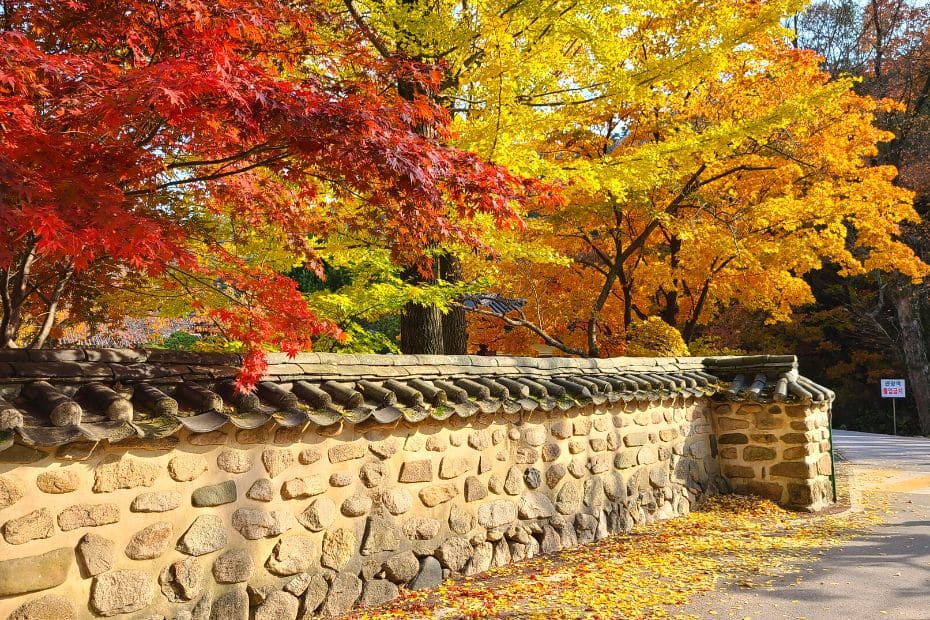
Why visit Korea in October? Simply put, it’s the best time of year to be in Korea. As someone who’s lived in Korea since 2015, I can say that October has the best weather, prettiest sights, and best food. Of course, there are many great months, but the autumn foliage puts October ahead.
Not only is the autumn foliage creeping across the country from north to south, there is a feeling of happiness and joy in Korea and Koreans that comes from the end of the brutal summer, which is horribly hot and humid. This joy is released in outdoor trips, festivals, and harvest celebrations.
If you’re like me and want to go hiking all over Korea’s 7,000+ mountains, October is definitely the best time to put on a pair of good boots and get outdoors. Even if you don’t want to hike, just see incredible autumn views on leafy slopes, there isn’t a better time than this cool autumn month.
Korea’s traditional food and destinations are also the stars of this busy month, with fresh harvest produce available to sample, such as succulent fruits and veg, crunchy nuts, and spicy chilli peppers. The best places to try these are in Korea’s historic cities, such as Jeonju, Gyeongju, and Andong.
Use the links below to jump straight to what you’re most interested in, or keep reading through to learn all there is about visiting Korea in October. I’ll introduce my personal favourite places, festivals, events, and foods, as well as give you a 1-week itinerary for October and my personal travel tips.
Planning to visit Korea? These travel essentials will help you plan your trip, get the best deals, and save you time and money before and during your Korean adventure.
Visas & K-ETA: Some travellers to Korea need a Tourist Visa, but most can travel with a Korean Electronic Travel Authorisation (K-ETA). Currently 22 Countries don’t need either one.
How To Stay Connected: Pre-order a Korean Sim Card or a WiFi Router to collect on-arrival at Incheon Airport (desks open 24-hours). Alternatively, download a Korean eSIM for you travels.
Where To Stay: For Seoul, I recommend Myeongdong (convenient), Hongdae (cool culture) or Gangnam (shopping). For Busan, Haeundae (Beach) or Seomyeon (Downtown).
Incheon Airport To Seoul: Take the Airport Express (AREX) to Seoul Station or a Limo Bus across Seoul. Book an Incheon Airport Private Transfer and relax to or from the airport.
Korean Tour Operators: Tour companies that have a big presence in Korea include Klook, Trazy, Viator, and Get Your Guide. These sites offer discounted entry tickets for top attractions
Seoul City Passes: Visit Seoul’s top attractions for free with a Discover Seoul Pass or Go City Seoul Pass. These passes are great for families and couples visiting Seoul – you can save lots.
How To Get Around: For public transport, grab a T-Money Card. Save money on Korea’s high speed trains with a Korea Rail Pass. To see more of Korea, there are many Rental Car Options.
Travel Money: Use money exchanges near Myeongdong and Hongdae subway stations for the best exchange rates. Order a Wise Card or WOWPASS to pay by card across Korea.
Flights To Korea: I use flight comparison sites such as Expedia and Skyscanner to find the best flights to Korea from any country. Air Asia is a good option for budget flights from Asia.
How To Learn Korean: The language course from 90 Day Korean or Korean Class 101 both have well-structured lessons and lots of useful resources to help you learn Korean.
Popular Korean Festivals In October 2025
October is a great time to experience cultural festivals in Korea. Travellers to Korea in October can not only experience traditional Korean festivals, such as the Andong Mask Festival and Jinju Lantern Festival, but also discover modern Korean culture at the Busan International Film Festival.
Please note: The exact festival dates for October 2025 won’t be available until spring or summer 2025. The dates used are based on the dates for October 2024 until the new dates are available.
Here are some of the biggest and best festivals in Korea in October for you to enjoy:
Jinju Lantern Festival 2025
The Jinju Namgang Yudeung Lantern Festival is a city-wide celebration that see the historic fortress, main bridge, river, and surrounding areas covered with colourful lanterns of varying shapes and sizes. The lanterns are lit at night and are an incredible sight to see. There are also cultural performances, food stalls, and events during the day, such as lantern making and lantern sailing. Visit in late afternoon and stay until it gets dark for the best views.
Festival Dates:
Oct 5 – Oct 20 2025
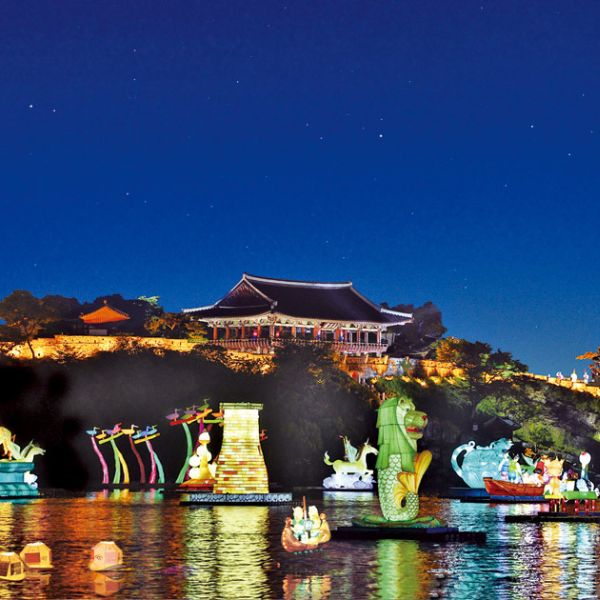
Andong Mask Dance Festival 2025
Featuring more than a week of performances, festivities, and events, the Andong Mask Dance Festival is one of the best festivals in Korea for those who want to experience traditional Korean culture. There are many other Korean activities and performances to enjoy, too, such as Taekwondo, orchestras, plays, and traditional games. Performers from other countries join in with their own performances, too.
Festival Dates:
Sep 27 – Oct 6 2025
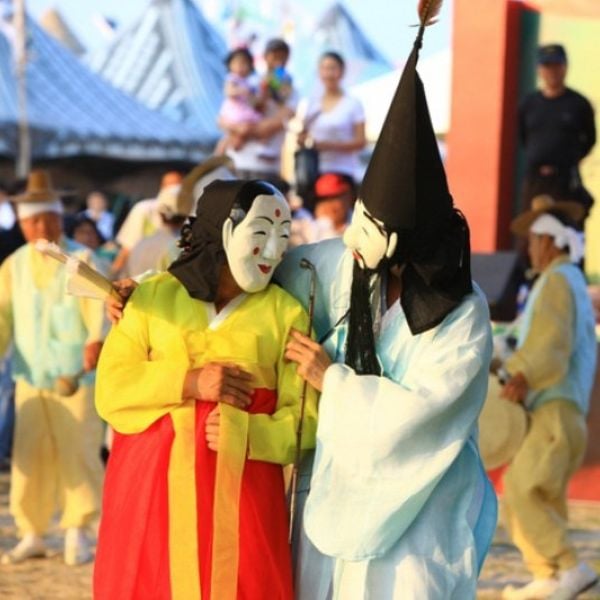
Busan International Film Festival 2025
The Busan International Film Festival (BIFF) is the Cannes of Asia, featuring around 300 movies from around the world and red-carpet events. See major movie stars attending worldwide and international premiers of over 100 movies each year. Featuring a wide range of genres on show, you’re sure to find something to enjoy. Hosted in various sites across Busan.
Festival Dates:
Oct 2 – Oct 11 2025

Busan International Rock Festival 2025
The Busan International Rock Festival is a two day music extravaganza that features many Korean and international bands over a number of stages at the grassy Samnak Ecological Park. Unlike most other Korean festivals, camping is allowed here and the nearby campsite allows for an authentic festival experience. Muddy, messy, musical, and a lot of fun, the Busan International Rock Festival is great way to enjoy a weekend out in October.
Festival Dates:
Oct 4 – Oct 6 2025
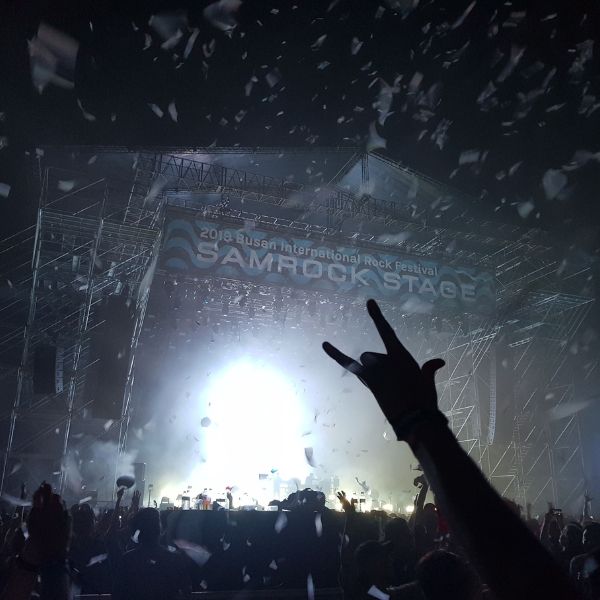
Gangneung Coffee Festival 2025
The Gangneung Coffee Festival is a celebration of all things coffee. Located in the coastal city of Gangneung, a popular beach destination that also has many popular cafes, this festival hosts barista awards, excellent coffee, and the chance to see the sea with a hot brew. Coffee installations and demonstrations are available in the city, as well as the chance to experience some of Korea’s best coffee.
Festival Dates:
Oct 24 – Oct 27 2025
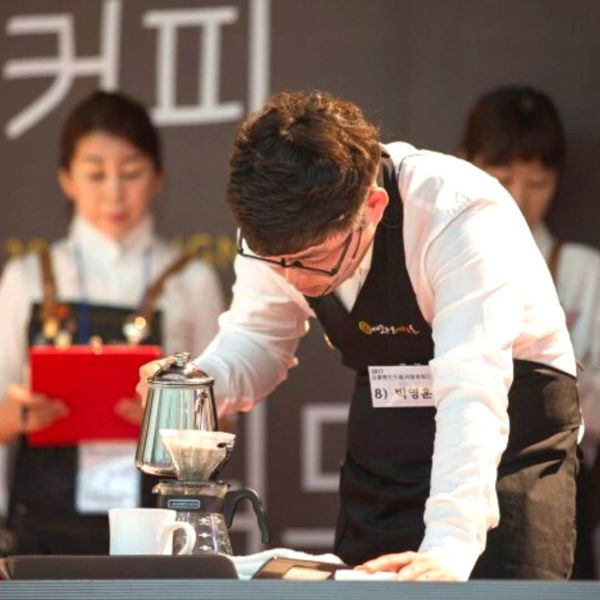
Baekje Culture Festival 2025
The Baekje Culture Festival is held in the two former capital cities of the Baekje Kingdom, one of the 3 major powers from Korea’s past. Located in Buyeo and Gongju, which are connected by the mighty Geumgang River, this 10-day celebration not only includes traditional Korean culture, but also modern K-Pop performances, lanterns, fireworks, food stalls, and lots more. The festival is held over 10 days, giving you the chance to visit both the Buyeo and Gongju celebrations.
Festival Dates:
Sept 28 – Oct 6 2025
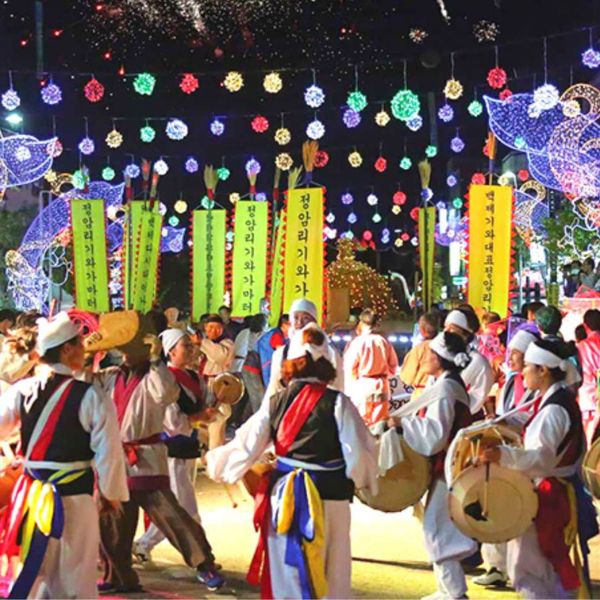
Seoul Fireworks Festival 2025
The Seoul International Fireworks Festival is held in Seoul in early October each year and is the first of the major fireworks festivals in Korea. Located in Yeouido, thousands of locals and tourists descend on Yeouido Hangang Park to see the colourful fireworks shooting out over the riverside and illuminating the city. There are over 100,000 fireworks set off each year with teams competing from various countries to create the best display in the night sky.
Festival Dates:
October 5 2025
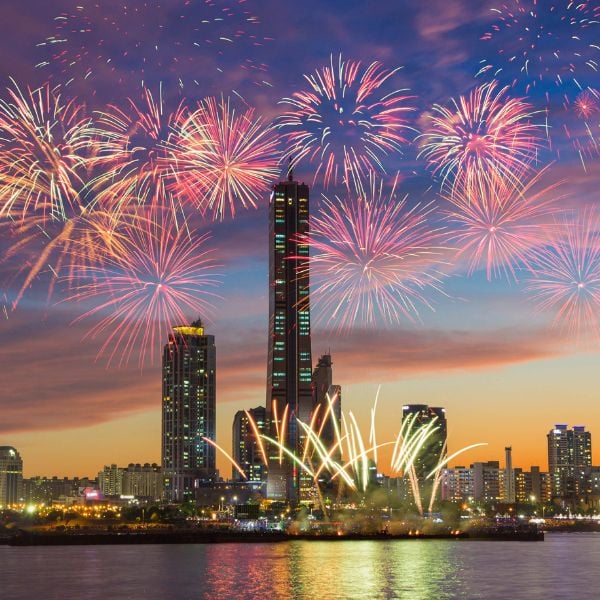
Regional Korean Festivals In October
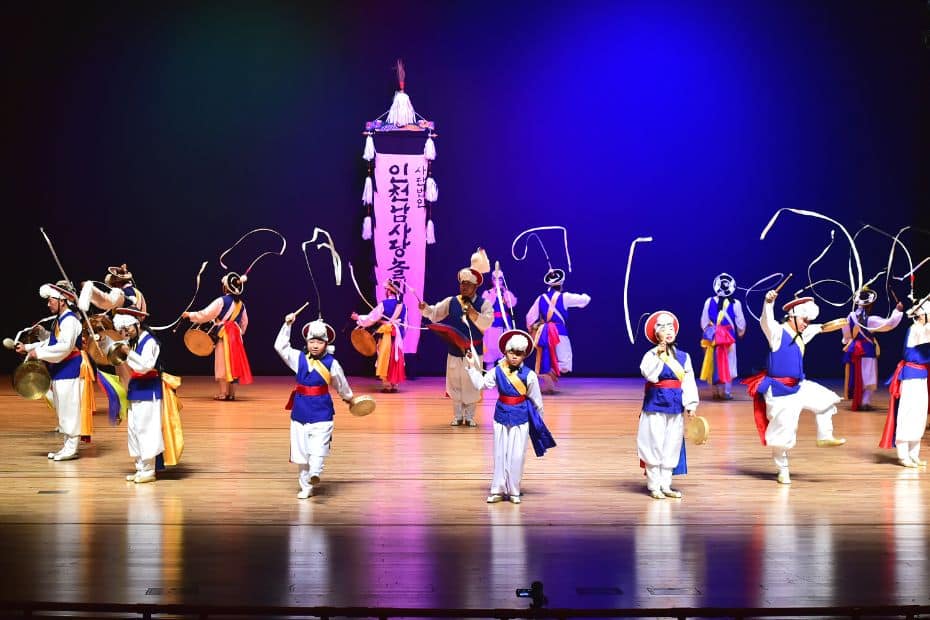
Here are some smaller regional festivals that might be of interest to you if you’re visiting Korea in October. These festivals may occur in September in some years as they’re usually around the Chuseok holidays, which follow the Lunar calendar.
- Gimje Horizon Festival 2025 (김제 지평선축제)
Oct 2 – Oct 6 2025 - Wonju Dynamic Dancing Carnival 2025 (원주 다이내믹댄싱카니발)
Oct 4 – Oct 6 2025 - Bupyeong Pungmul Festival 2025 (부평풍물대축제)
Sep 27 – Sep 29 2025 - Bucheon International Comics Festival 2025 (부천국제만화축제)
Oct 3 – Oct 6 2025 - Hanseong Baekje Cultural Festival Seoul 2025 (한성백제문화제)
Sep 27 – Sep 29 2025 - Sancheong Medicinal Herb Festival 2025 (산청한방약초축제)
Sep 24 – Oct 6 2025 (Dates TBC) - Korea Wine Festival Yeongdong 2025 (영동와인연말기획전)
May 24 – May 26 2025 - Seosan Haemieupseong Fortress Festival 2025 (서산해미읍성역사체험축제)
Oct 2 – Oct 5 2025 - Jinan Red Ginseng Festival 2025 (진안 홍삼축제)
Oct 3 – Oct 6 2025 - Nonsan Ganggyeong Salted Seafood Festival 2025 (논산강경젓갈축제)
Oct 12 – Oct 16 2025 (Dates TBC) - Gwangju Chungjang Festival 2025 (추억의 충장축제)
Oct 2 – Oct 6 2025 - Silla Cultural Festival Gyeongju 2025 (신라문화제)
Oct 11 – Oct 13 2025
These regional festivals don’t attract as many tourists, but can give you an interesting look at life in Korea and offer a chance to learn more about Korean culture.
Tours & Events In October 2025

The best way to explore Korea is to get out into the streets of Seoul and other cities and walk around to get a feel for the culture and atmosphere of that place. However, many of the best places to visit in October are outside of the big cities and best accessed with a guided tour from Seoul or Busan.
I take many tours during October and other months of the year as they’re reasonably priced, provide convenient transportation directly to each location, and come with a helpful guide. Having a tour guide in Korea is especially useful as Korean attractions don’t always provide much info in English.
Here are some of the best tours you can take in Korea this October:
Events In Seoul This October
October is a popular time not only for festivals and tours, but also lively and exciting events. Seoul is home to many cultural performances, both Korean and international, and adding one of these events to your Seoul itinerary is a great way to spend an evening out.
Here are some fun events you can check out in Seoul this October:
Please note: These events were for October 2024 and October 2025 events may differ. I will update what events are on in Seoul during October 2025 closer to the date. Some events, such as Nanta Cooking Musical, continue year round and should be on in October.
| Event Name | Prices From ~ |
|---|---|
| Van Gogh: The Immersive Experience | ₩24,000 |
| The Painters at Myeongbo Art Hall | ₩40,000 |
| Jazz Society Live at Seoul Brewery | ₩15,000 |
| Saturday Gugak Concert Ticket | ₩8,000 |
| The Painters: Season 2 – Show in Seoul | ₩37,500 |
| Nanta Cooking Musical in Seoul | ₩32,700 |
October Is Peak Season In Korea!
Due to the warm weather, public holidays, and autumn foliage, travelling in Korea in October is very busy with tours and hotels booked up in advance. October is peak season in Korea, along with April and May. April is busy due to the blooming cherry blossoms, which is another great reason to visit Korea.
Popular destinations such as national parks (autumn leaves), historic cities (Gyeongju), and tourist spots such as Seoul and Jeju Island will be particularly busy, especially on the weekends. I recommend booking as much as possible in advance (hotels, tours, transportation) to avoid disappointment.
Best Activities To Enjoy In October 2025
There are so many things to do in Korea in October that you might find you don’t have time to do them all. From autumn foliage spotting, to riding along riversides, sleeping in Buddhist temples, and exploring night markets, you’ll not get bored during this autumn month.
Below are some of the most popular things to do in October. Of course, there are many other popular activities that you can do at any time of year in Korea, such as wearing Korean hanbok, touring royal palaces, soaking in a Korean sauna, singing in a noraebang, and more.
See Incredible Autumn Foliage
Where: National parks, royal palaces, parks, and many other places.
The number one thing to do in Korea in October has to be visiting the autumn foliage that starts to appear at the start of the month. Seoraksan National Park on Korea’s east coast is where it all begins, with the leaves turning golden in early October. By the end of October, trees across the country will have started to drop their leaves. National parks are the best places to visit for autumn foliage in Korea.
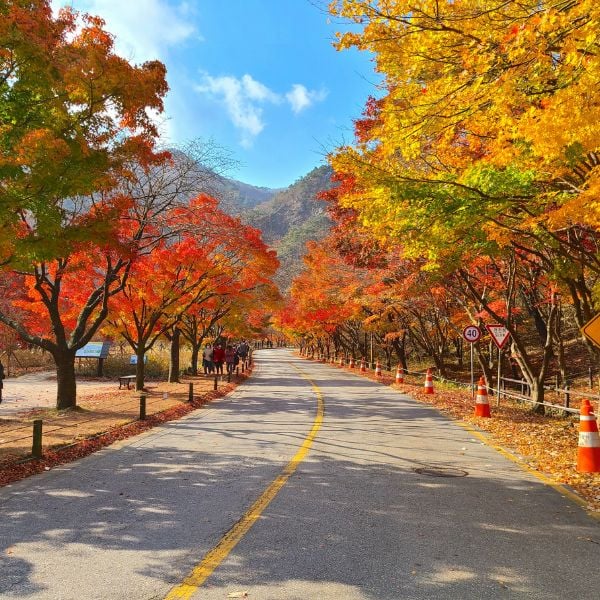
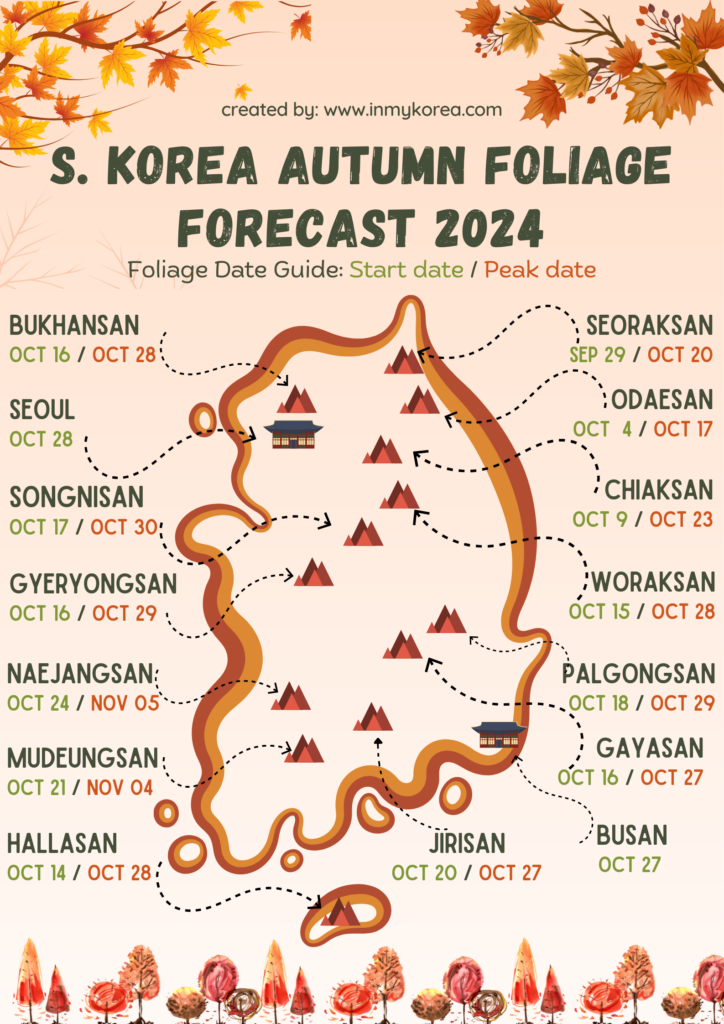
South Korea Foliage Forecast 2025
To help you plan when to see the autumn foliage in Korea this autumn, here’s the most up-to-date fall foliage forecast. This forecast shows you the expected dates for the fall foliage in Korea in 2025. Start and peak foliage times typically stay within 1 week of the dates of the previous year.
The start of autumn foliage in Korea in 2025 is September 29 in Seoraksan National Park, with the foliage peaking from October 20th there. Other places start and peak over the following five weeks.
On October 28, Bukhansan Mountain will hit its highest point. On October 23, Jirisan Mountain will do the same, followed by Naejangsan Mountain on November 5. Finally, on October 28, Hallasan Mountain in Jeju will do the same. When 20% of the trees have changed color, it’s called “first foliage.” When 80% of the trees have changed color, it’s called “peak foliage.”
Go Hiking Or Trekking
Where: National parks, royal palaces, parks, and many other places.
Not only can you see beautiful autumn foliage in Korea in October, it’s also one of the best times to go hiking or trekking. Korea is blessed with hundreds of mountains with thousands of hiking and trekking paths, each offering amazing views of the Korean countryside. There are plenty of walking paths for those who don’t want to hike. Find out why hiking and trekking are such popular hobbies in Korea this October.
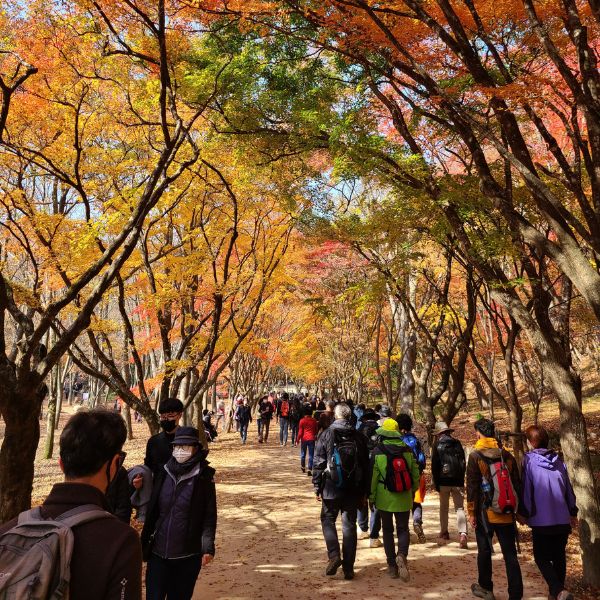
More Info: Check out my seasonal hiking guide for info about the best places to visit in each season, how to prepare, and where to hike. Want to hike Seoul’s highest mountain? This guide to hiking Baegundae Peak in Bukhansan National Park will tell you all you need to know to hike.
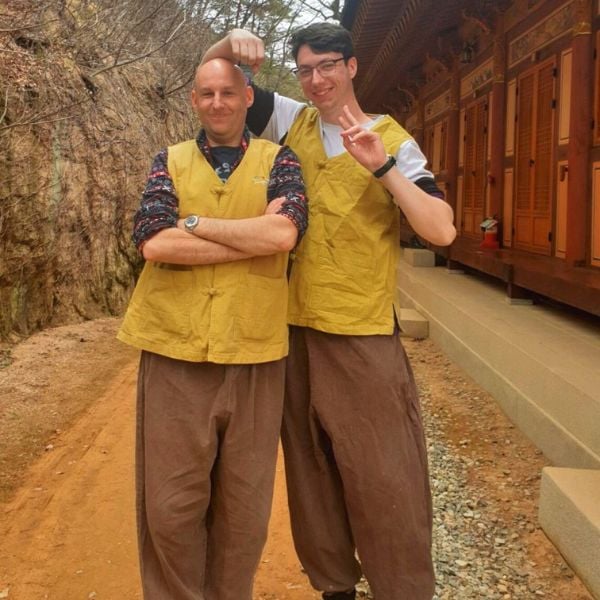
Join A Temple Stay Program
Where: Yakcheonsa Temple (Jeju), Bulguksa Temple (Gyeongju), Beopjusa Temple (Songnisan National Park).
The Korean Templestay Program offers you the rare chance to witness life inside a Korean Buddhist temple. Eat healthy vegan food, cleanse your mind, appreciate more, and chat with Buddhist monks during a traditional Korean tea ceremony. The best way to experience a temple stay is the overnight course, where you wake up before sunrise and join the monks in their morning rituals and worship.
More Info: I’ve been on several temple stays and shared my experiences in this article about temple stays in Korea, which tells you what to expect, what’s included, and how to book a temple stay.
Visit A Night Market
Where: Seoul (Bamdokkaebi Markets, Namdaemun Market), Daegu (Seomun Market), Seogwipo (Maeil Olle Market).
October evenings are still quite warm and there are plenty of night-time activities to enjoy in Korea’s cities, including a trip to a night market. Traditional markets host night markets in some cities and there are seasonal night markets, usually between spring and autumn when it’s warmer. Seoul’s Bamdokkaebi (night goblin) night markets are some of the best. There are stalls run by locals selling craft goods, jewellery, cosmetics, art, food and more.
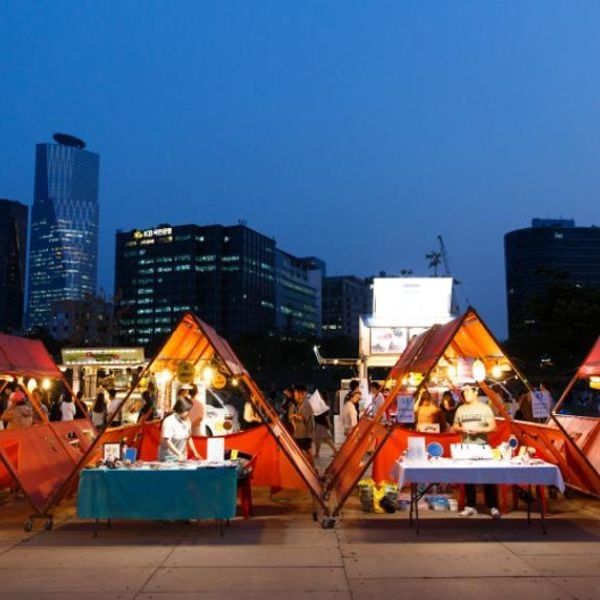
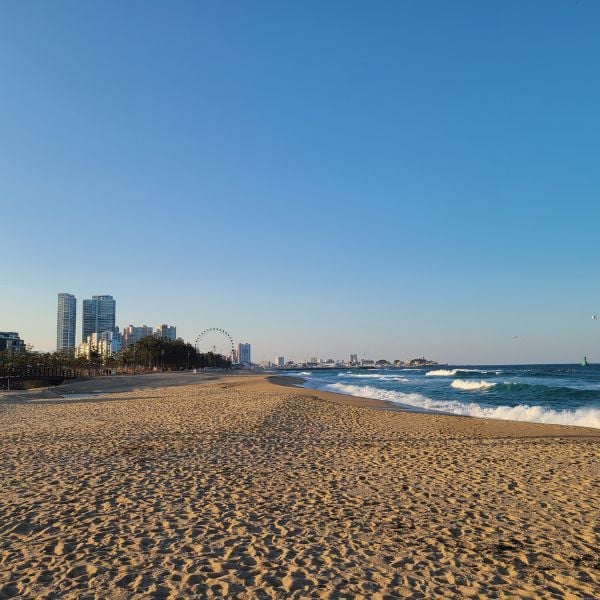
Relax By The Beach
Where: East Coast – Sokcho, Gangneung, and Surfyy Beach. Busan – Haeundae, Songjeong, and Songdo Beach.
Summer in Korea may be over before October, but it’s still warm during the day with clear blue skies (unlike summer which is often wet). Korea has many great beaches to relax on in popular destinations like Jeju Island, Busan, and the south coast (Geoje, Tongyeong). These will be slightly warmer than the northern parts of Korea. If you’re hiking Seoraksan, Sokcho Beach is nearby and a good place to recover.
Rent a Bike And Ride
Where: Bikes can be rented in Seoul and other cities such as Daejeon and Busan.
October days are perfect for renting a bike and exploring more of Korea. Bike rental systems are in place in most major cities, as well as tourist spots like Nami Island. Costs for public bike rental are cheap, starting at as little as 1,000 per hour. Good spots to ride in Seoul are along the Han River parks, especially near Yeouido Island, Haneul Park, and Seoul Forest. There are wide lanes dedicated for cyclists with views over the Han River, parks and cityscape.
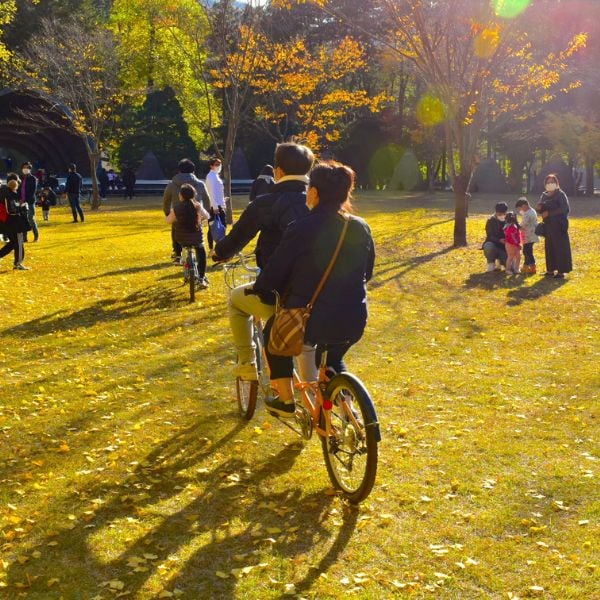
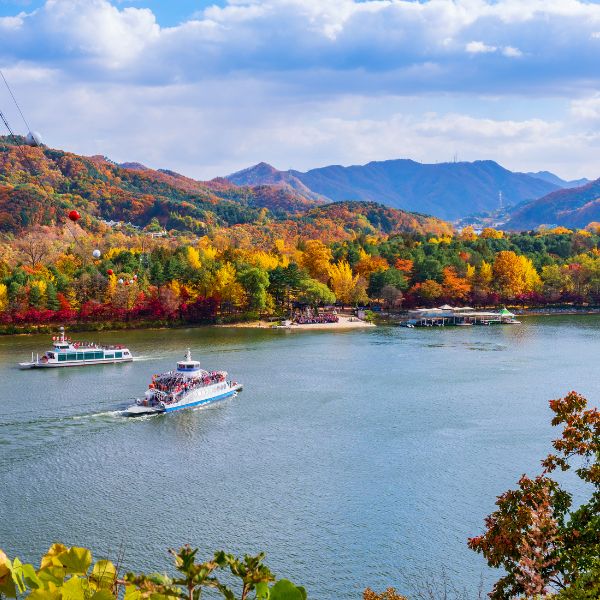
Take A Day Trip
Whether you’re in Seoul, Busan, Jeju or elsewhere in October, the blue skies and calm weather make this the perfect time to spend a day getting out and about. Grab a quick breakfast and take the train out to see an historic fortress, beautiful bamboo forest, green tea plantation, or even the world’s most dangerous border. While day trips can often be a bit more expensive than exploring by yourself, they’re usually the most memorable part of your journey.
October Day Trips From Seoul
Here are a few popular day trips from Seoul that you can enjoy in October (or any month). To book day trips and tours in Korea, I recommend using Klook, Get Your Guide, or Viator. They have a large presence in Korea and offer a wide range of easy-to-book tours in October and all months.
Nami Island & The Garden of Morning Calm
See the best of Gapyeong County with these charming spots of natural beauty. Nami Island hosts wild animals (rabbits, deer), tree-lined pathways, cafes, and cultural performances. The Garden of Morning Calm is one of the prettiest walks you’ll experience in Korea, passing through carefully curated displays of flowers, trees, and traditional Korean architecture.
For directions to these places, check out my guide to getting to Nami Island.
DMZ (Korean Demilitarised Zone)
Top on many traveller’s list of day trips from Seoul is the Demilitarised Zone (DMZ). There are so many reasons to visit the DMZ. Whether you want to learn about Korean history, experience a real-life war zone border, or simply want a chance to step over into North Korea, this is a uniquely Korean trip.
Suwon Hwaseong Fortress
A short journey from Seoul, Suwon hosts the historic Hwaseong Fortress, complete with nearly 6km of fortress walls, palaces, fortress gates, and other buildings. Nestled amongst historic beauty is a pretty river, parks, cafes, and Suwon’s famous Fried Chicken Street – home to Korea’s best fried chicken!
Everland & Caribbean Bay
Theme park fans and thrill seekers will find this to be one of the best day trips from Seoul. Everland is Korea’s largest theme park and boasts the world’s steepest roller coaster. Caribbean Bay is one of the world’s largest water parks. With loads of rides, this is the best place to have fun this October.
Best Places to Go During October
Besides fun festivals and exciting events, there are lots of places to visit during October that will show you Korea’s natural beauty and traditional charms. Pink muhly in Gyeongju, golden ginkgo in Asan, silvery reeds in Seoul, fall foliage all around. Here are 5 great places to visit this October:
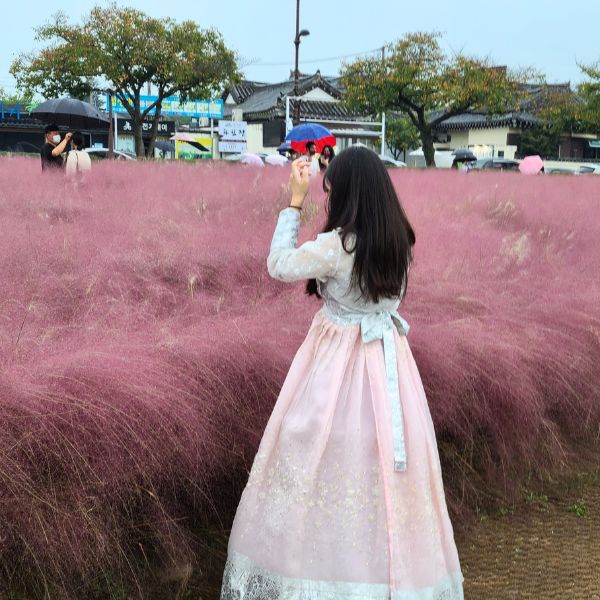
Beautiful Gyeongju City
Gyeongju is an historic Korean city that is known as Korea’s outdoor museum due to the large number of ancient buildings standing around the city and nearby, including Cheomseongdae Observatory, Wolji Pond, Bulguksa Temple, and dozens of tombs. The city is also famous for its nature, with an ocean of pink muhly bushes coming to life in October, as well as cosmos and autumn foliage. Visit Bomun Lake for scenic sights of fall foliage with reflections in the water.
When To Visit: Mid to late October is the best time to visit for pink muhly and autumn leaves. Weekends will be extremely busy, so travel during the week if possible.
How To Get There: Take the KTX train from Busan to Singyeongju Station, then bus or taxi to the historic area. Bulguksa Temple and Bomun Lake are outside the city and require a separate bus from the city centre. Buses run from Gimhae Airport or Busan Central Bus Terminal to Gyeongju.
Tour Options: Here are some tours that will take you to Gyeongju from Busan
- Gyeongju The Old Capital of Korea One Day Tour from Busan – ₩80,000
- Gyeongju UNESCO World Heritage Tour from Busan – ₩91,300
- Gyeongju UNESCO World Heritage One Day Tour – ₩117,000
- Gyeongju 1 Day Tour from Busan – ₩85,000
Seoraksan National Park
One of the most popular national parks in Korea during autumn, Seoraksan National Park has incredible views, Buddhist temples, cloudy vistas, and many other attractions. Thanks to its location close to the north-east coast, Seoraksan is one of the first places to see autumn leaves in Korea and makes for a great place to hike for people staying in Seoul, Sokcho, or nearby Gangneung. If you’re not a hiker, you can ride the cable car to the top instead.

When To Visit: Seoraksan autumn foliage starts at the end of September, but mid-October is the best time to visit to see them at their peak.
How To Get There: Seoraksan National Park is located 2.5 hours away from Seoul and can be reached by car or bus. Take an intercity bus to Sokcho, then transfer to a local bus to the national park. Tours are an easier option that avoid time consuming transfers.
Tour Options: Here are some tours that will take you to Seoraksan from Seoul
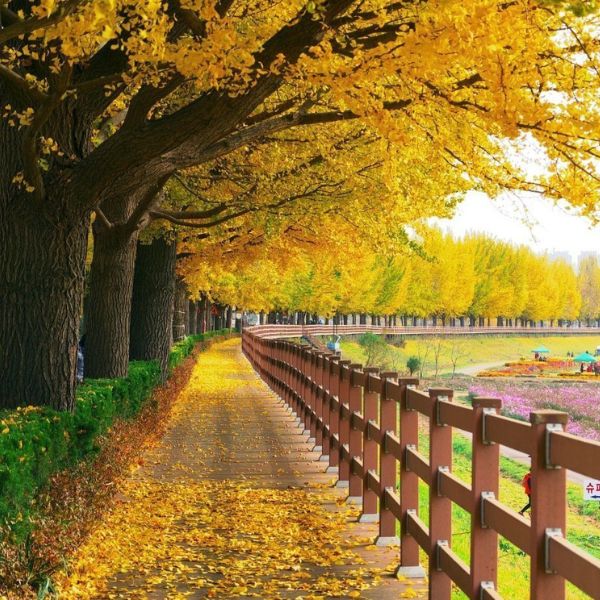
Asan Gingko Tree Road
There are two trees that are perfect for seeing autumn leaves in Korea: maple and gingko. The Asan Gingko Tree Road specialises in the latter and is the best place to see this gorgeous golden cascade of colours. Imagine strolling down the beautiful, tree-lined streets of Asan Gingko Tree Road, with a carpet of golden leaves below, and lemony clouds above. Gingko trees are famous for their many leaves that slowly drop their leaves, waiting for you to tread on.
When To Visit: Ginkgo trees are one of the last to shed their leaves so the end of October is the perfect time to visit to see them on the ground. To see them on the tree, visit in mid-October.
How To Get There: To get to Asan Gingko Tree Road, take the KTX from Seoul Station (40 minutes) or on Subway Line 1 (over 2 hours) to Asan Station, then take a taxi to Asan Gingko Tree Road (은행나무길 in Korean).
Haneul Sky Park Seoul
Another natural wonder that you can experience in Korea in October is an ocean of tall silver reeds (Eulalia) gently swaying in autumn winds. The best place to see these reeds in Seoul is at Haneul Sky Park, which hosts the Silver Grass Festival in October. This festival lets you walk through a maze of reeds, take pictures at the photo zones, and look out over the beautiful Han River below. Mindungsan Mountain is another great place for silver reeds.
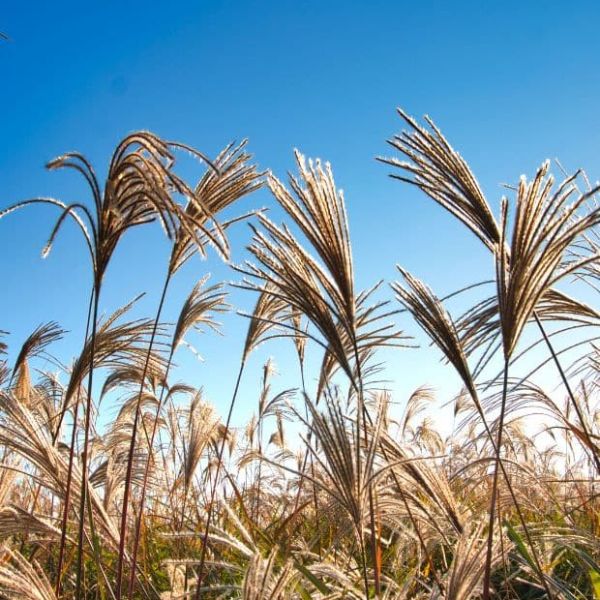
When To Visit: Silver reeds are around for most of autumn and any time in October should be a good time to see them at Haneul Sky Park.
How To Get There: Take a subway to World Cup Stadium (Line 6 – brown) and head towards the rivers. There are many parks in this area. Haneul Sky Park is on top of the hill – you can’t miss it. You can also find the Oil Tank Culture Park here, a free attraction in Seoul that is worth a visit.
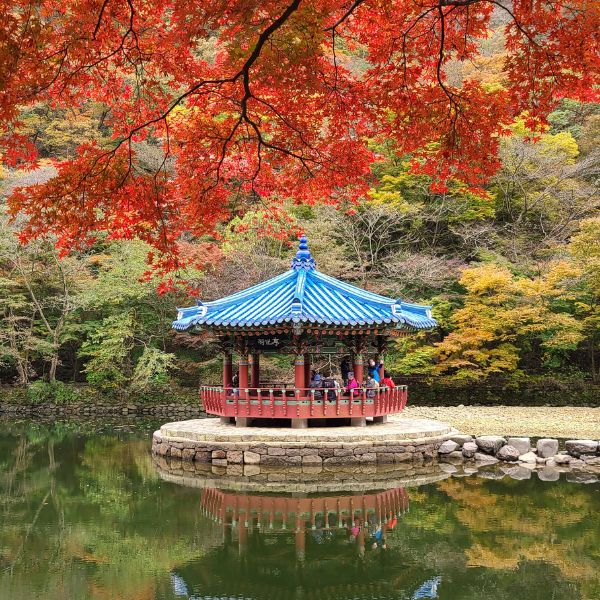
Naejangsan National Park
Literally meaning ‘concealed inside’, Naejangsan has a treasure trove of hidden wonders that offer awe-inspiring photo opportunities, beautiful backgrounds, and the chance to find spiritual calm among natural beauty. Late-October and early-November are the best times to visit Naejangsan as the autumn leaves start to turn fiery red and golden yellow. Truly one of the most iconic fall foliage spots in Korea, Naejangsan is a must for picture-postcard memories of Korea.
When To Visit: Naejangsan autumn foliage peaks at the start of November, but you can still see lots of colourful leaves at the end of October.
How To Get There: Take the KTX train to Jeongeup Station and transfer to local bus 171 to get to the park. Check out this article about getting to Naejangsan National Park, which also includes lots of useful info about what to see, do, and eat in the park.
Tour Options: Here are some tours that will take you to Naejangsan from Seoul or Busan
Korean Foods To Try In October
October in Korea is the best time to get fresh fruits, vegetables, and other locally grown produce when it’s ripest and ready to be plucked or pulled and then eaten. Korean foods you’ll find in October include chestnuts, slim chilli peppers, cabbages, jujube, persimmons, sesame plants, and lots more.
If you walk through a Korean village, or go mountain hiking, you’ll see an array of colourful foods on farms or for sale in traditional markets, street corners, or even from the back of a lorry. Some of it you can even pick up from the ground. Watch out for chestnut shells if you’re hiking in Korea’s mountains.
Korean Pancakes (Jeon)
If you’re visiting one of Korea’s gorgeous national parks, then you’ll definitely find somewhere to get some jeon (전). Jeon is a form of pancake that comes with various ingredients. Popular options include gamja-jeon (potato), kimchi-jeon (kimchi), or haemul pajeon (seafood & green onion). These are cooked fresh at the entrance to the park and are the perfect reward after a day of hiking. Grab a bottle of makgeolli to go with it.

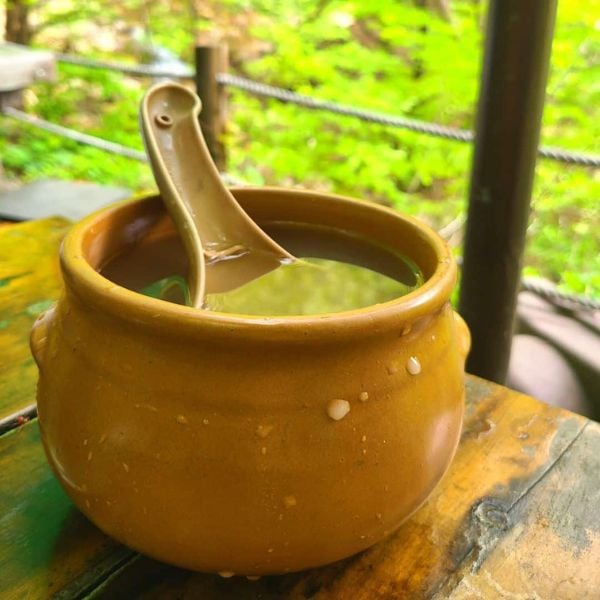
Korean Rice Wine
Another staple of any trip to the mountains in Korea is a cup (or bowl) of traditional Korean rice wine. The most common forms of Korean rice wine are makgeolli (막걸리) and dongdongju (동동주), which are both made by fermenting rice. Makgeolli is like a mix between wine and yogurt (with lots of healthy bacteria), while dongdongju is not as creamy. Both are delicious on a hot day in October and come in a variety of flavours such as chestnut, sweetcorn, date, and banana.
Rice Cake Sweets
Rice cakes are used in lots of traditional Korean dishes, from tteokbokki to budae jjigae, as well as sweet snacks like the ones in the picture. These are called songpyeon (송편) and are rice cakes stuffed with sweet fillings such as red beans, sweetened sesame seeds, honey, or chestnuts. The cakes are steamed over a bed of pine needles, which is where they get their name (songpyeon means ‘pine tree’ in Korean). You can find these in temples, Korean tea houses, and other traditional locations.
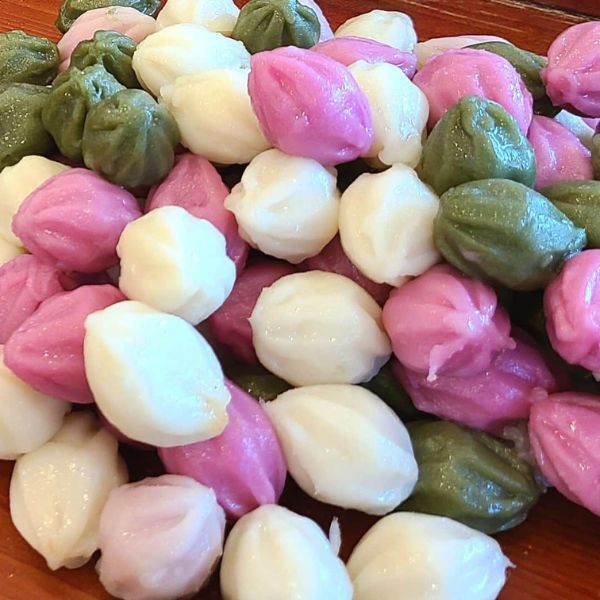
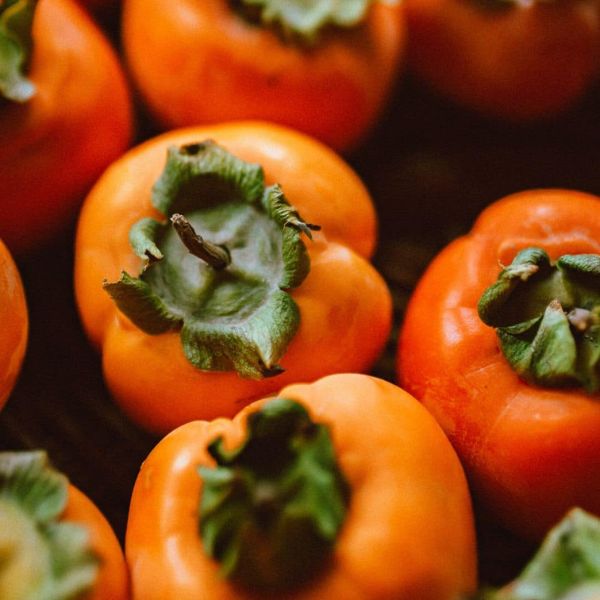
Persimmons
Another autumn delicacy that you’ll spot stubbornly clinging to the trees in October are bright orange persimmons or gam (감). These are common in Korea and if you walk through the countryside, you’ll see hundreds stuck on trees or hung out to dry. The best way to eat them is to stick them in the freezer and then open it up and eat it with a spoon. If you’re not up for that, grab some dried persimmons (gotgam 곶감) instead. These are cheap and healthy snacks you’ll find all over Korea.
Jujube (Red Dates)
Jujube are red dates (Chinese dates), known as daechu (대추) in Korea, that look more like a small apple than traditional dates. These healthy fruit are used a lot in traditional Korean medicines and are said to reduce stress or prevent ageing. You can find them for sale in traditional markets in national parks after they’re freshly picked, or sold in many different forms in other places. They are used for teas and other drinks, including makgeolli and dongdongju.
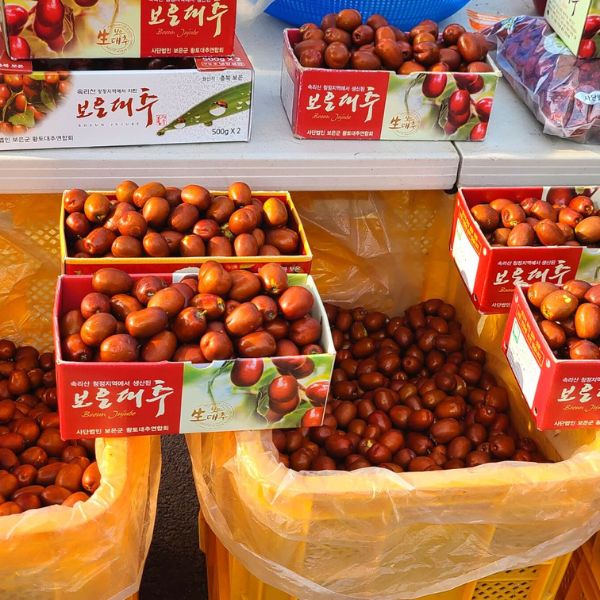
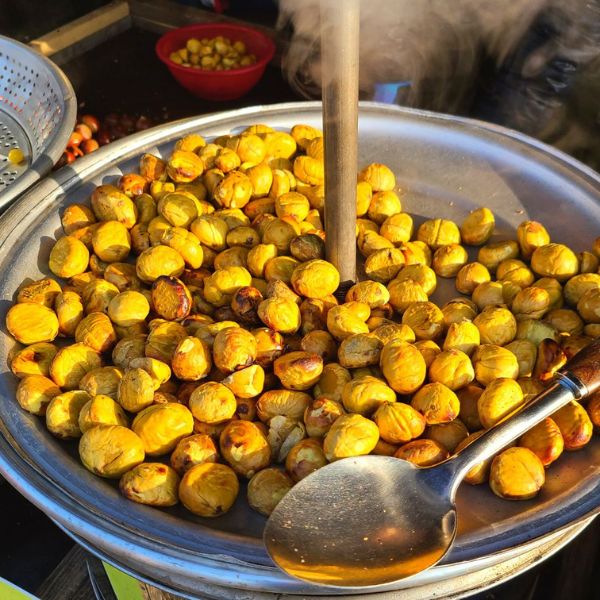
Chestnuts
Chestnuts, or bam (밤) in Korean, are a staple snack that you’ll find throughout autumn and winter in Korea. These fall from the trees in their spiky shells throughout autumn, so watch out as you’re hiking. The nuts have a smoky flavour that’s not sweet. The best way to enjoy chestnuts in Korea is when they’re roasted, known as gunbam (군밤), in chestnut bread, or in chestnut makgeolli, which is popular in Gongju and can be found at the Baekje Culture Festival.
Weather & Public Holidays During October
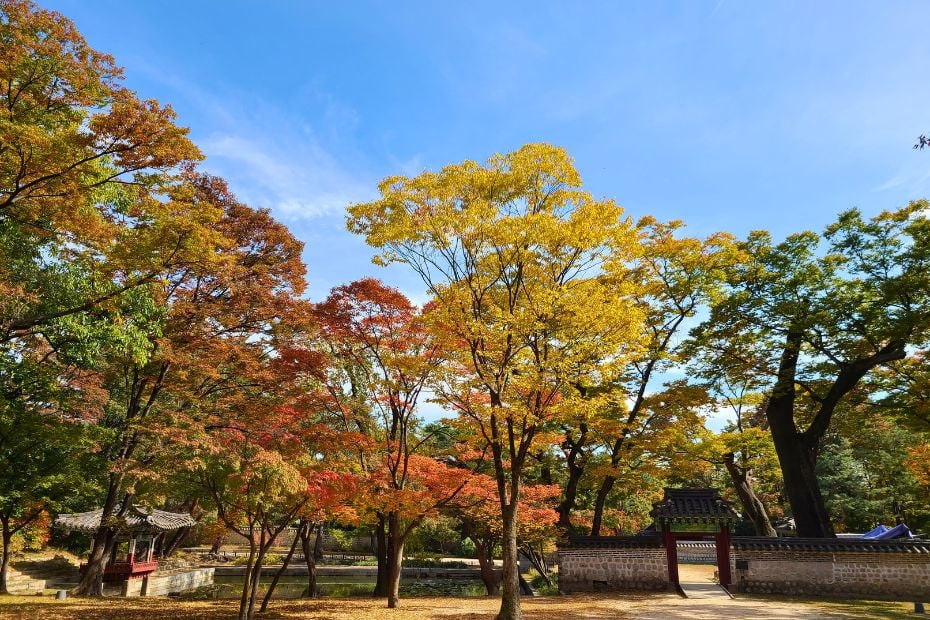
What is the weather like in Korea in October? Absolutely amazing. The weather is still warm in most parts of the country during the day, but cold in at night. Jeju Island in the south is a few degrees hotter on average than Seoul, which is in the north. The skies are mostly blue, too.
Temperatures range from 15 to 25 (Celsius) during the day and 5 to 15 at night. It can get as low as 0 at night, but that’s not common. It’s best to bring warm weather clothes for late October, however, in 2024, the summer heat lasted longer than expected and it was still over 25 degrees in November!
October has less rain than July and August, the wettest months in Korea, and is less humid. There is still rainfall during October, but it’s not as common and doesn’t last more than a few days. Expect to see clear blue skies with thin, streaky clouds on many days in October, like in the picture above.
In my experience, there are more good weather days than bad in October, however, it’s not always perfect. One of the best things about visiting Korea in October is the lack of fine dust. Air pollution is at its lowest at this time of year. Air pollution numbers start to rise in winter and peak in spring.
Average Daily Temperatures In October
Here’s the range of temperatures you can expect during October in Korea. The daytime is warm and can range from 15 to 25 degrees, while nighttime is colder, ranging from 5 to 15 degrees. There can be lower temperatures when there’s bad weather, but it’s not that cold in October.
| Day Temp (Avg.) | Night Temp (Avg.) |
|---|---|
| Low: 15 | Low: 5 |
| High: 25 | High: 15 |
Typhoon Season In Korea
Technically, October is part of typhoon season in Korea. That means there can be some extreme weather, including strong winds, waves, and heavy rain. Typhoons don’t often hit mainland Korea and usually only affect the southern regions. Jeju Island, Busan, and southern areas are more at risk than places like Seoul and Gyeongju.
There’s not much that can be done about typhoons, and it’s very hard to predict where they’ll actually hit, but it’s good to keep an eye on the weather forecasts and to have backup plans.
Public Holidays In October
There are a couple of public holidays that fall in October each year, as well as a big holiday that is in October on certain years. It’s useful to know about these public holidays as they can affect your travel plans. Some places may be closed and popular places may be busier than normal.
Chuseok: Autumn Harvest Festival
Chuseok, also known as Korean Thanksgiving, is an autumn harvest festival that celebrates the bountiful harvest for that year. This is one of Korea’s biggest holidays and usually lasts for 3-4 days with millions of Koreans returning home to spend time with their family. The dates are based on the lunar calendar, and therefore change every year.
Chuseok Dates:
Sep 16 – Sep 18 2025
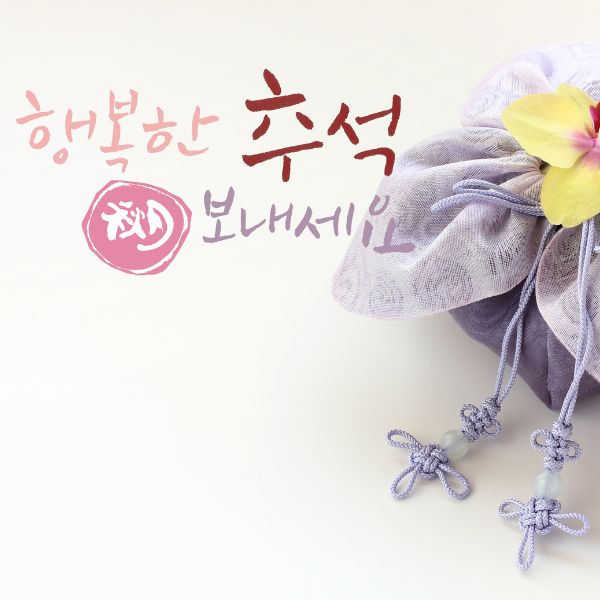
Chuseok Dates For 2025 & Beyond
Although Chuseok occurs most often in September, it can land in October, too. The next time Chuseok is in October will be in 2025. The last time Chuseok was in October was in 2020. Here are the dates for the Chuseok holiday for the next few years:
| Year | Start | End |
|---|---|---|
| 2024 | Sep 16 (Mon) | Sep 18 (Wed) |
| 2025 | Oct 5 (Sun) | Oct 7 (Tue) |
| 2026 | Sep 24 (Thu) | Sep 27 (Sun) |
National Foundation Day: October 3rd
National Foundation Day, also known as Gaecheonjeol in Korean, is a public holiday at the start of October that celebrates the Korean creation story and founding of Korea in 2333 BC.
Hangul Day: October 9th
Hangul Day, or Korean Alphabet Day, is a public holiday in Korea designed to commemorate the creation of the Korean alphabet in the 15th Century by King Sejong the Great. If you’re interested in learning the Korean alphabet, here are some really useful free resources to learn Korean.
My Tips For Exploring Korea During October
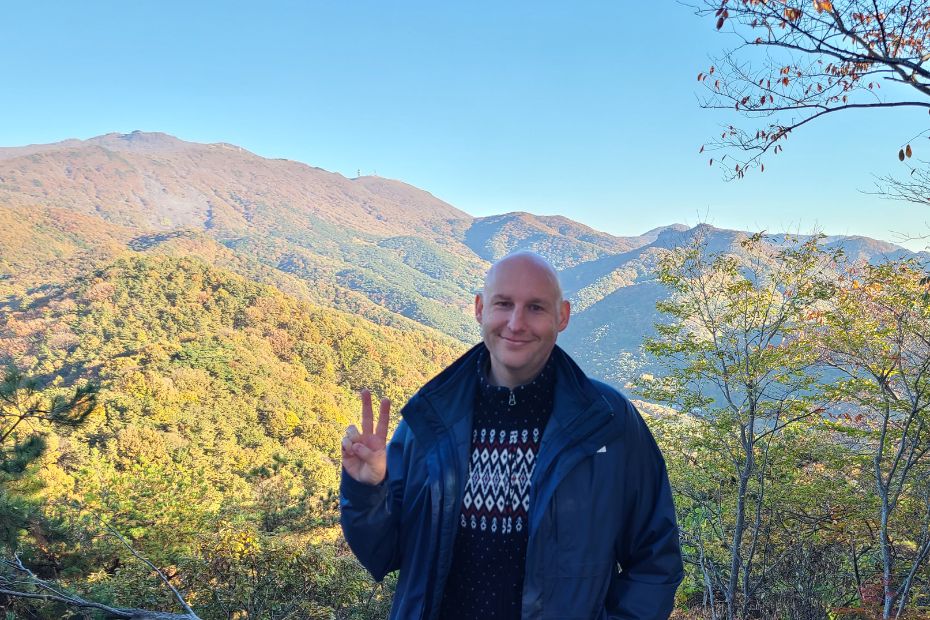
This final section is a collection of my personal tips and recommendations for travelling in Korea in October and how to get the most out of this colourful month. There is a one-week itinerary for October which takes you to some of the best sights, including Seoraksan, Gyeongju, Suwon and more.
Next is a guide to what to wear in Korea during October, explaining how warm or cold it can get, what to pack to dress comfortably, and examples of what I wear at this time. Finally, there are a few of my own tips for travelling during October. October is a busy month and there’s a lot of be aware of.
Recommended Itinerary For October In Korea
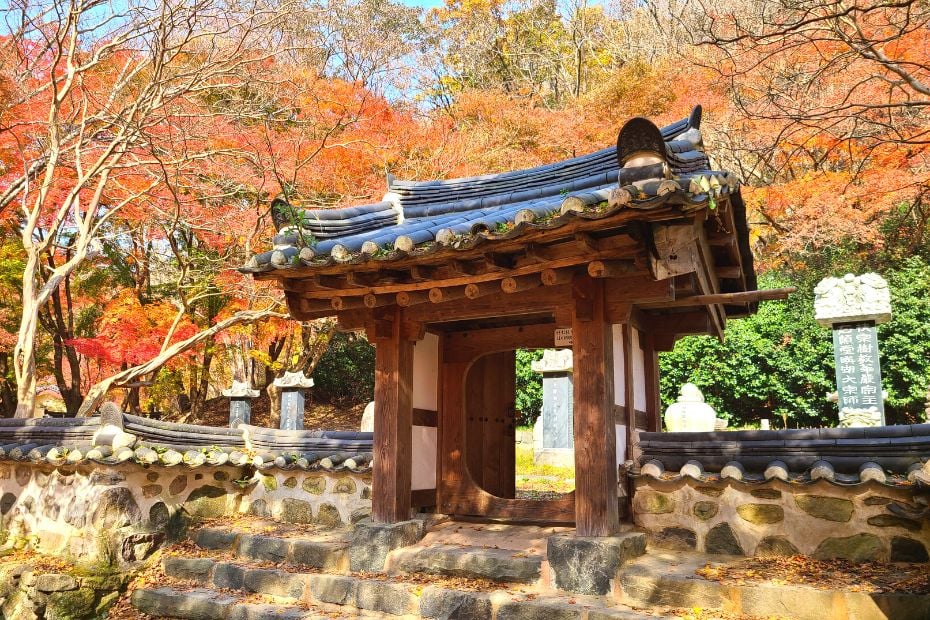
Planning to visit Korea in October but not sure where to go for the best sights and experiences? This 7 day itinerary will help you get started planning your October adventure.
The itinerary uses 2 cities as a base (Seoul and Busan), but will take you far and wide across Korea; to mountains looking over the east coast, to Korea’s historic capital, to ancient fortresses, and to lots of beautiful autumn foliage spots.
Day 1: Seoul Sights
As most flights arrive to Korea via Incheon Airport, which is just outside Seoul, it’s usually best to spend a bit of time in Seoul getting over jet lag and embracing Korea’s capital. If you stay in Myeongdong, you can easily get access to the royal palaces, N Seoul Tower, Insadong Art Street, Myeongdong street food and markets, Dongdaemun Design Plaza, Jogyesa Temple, and lots more. Spend the day walking, eating, and seeing the sights.
Here are some great Budget Hotels in Myeongdong that I personally recommend.
Day 2: Seoul River Parks
The Han River is a wide stretch of water that splits Seoul right in the middle. Check out Haneul Sky Park and Oil Tank Culture Park on the north side of the river, stop by Hongdae for some lunch, then head over the river to Yeouido Hangang River for more parks and natural beauty. Take the subway to Gangnam to see the massive COEX Mall, K-Pop sights, Bongeunsa Temple, and eat dinner in the Apgujeong area.
Day 3: Seoraksan Day Trip
Get up early and take a day trip to Seoraksan National Park, passing through the beautiful Korean countryside on the way. Follow the easy valley walking paths, past historic Korean temples and shrines, hike to the peaks, or take the cable car to the mountaintop. Try a traditional hiking dinner – pajeon and makgeolli for an authentic Korean experience.
Day 4: Suwon or Jeonju Day Trip
Take a day trip to Suwon or Jeonju and explore the historic areas in either city. Suwon is home to Hwaseong Fortress. Walk the walls in the morning, explore the fortress grounds in the afternoon, try your hand at Korean archery, stop off in a cafe, and enjoy Korea’s best fried chicken at night. Jeonju hosts Korea’s largest hanok village with more than 700 traditional Korean hanok houses. Dress up in hanbok, eat traditional Korean snacks and dishes, and discover Korea’s past.
You can get to both of these cities through a guided tour or on the KTX trains.
Day 5: Busan Beaches
Ride the KTX train from Seoul to Busan in under 3 hours and see a different side of Korea in its second largest city. Known for its beaches, seafood markets, and maritime history, Busan is less busy than Seoul, but just as fun. Haeundae is a good place to stay, as well as the central Seomyeon district. Spend the day visiting the beaches (Haeundae, Songdo, Gwangalli, Songjeong), exploring the colourful Gamcheon Culture Village, riding the Haeundae Blue Line Train (a good way to get from Haeundae Beach and Songjeong Beach), or checking out Jagalchi Fish Market and the nearby Nampo shopping area.
Day 6: Gyeongju Day Trip
From Busan, take a short train ride to Gyeongju, the former capital city of the Silla Kingdom. Discover historic sights, including Bulguksa Temple, Wolji Pond, Cheomseongdae Observatory, Woljeonggyo Bridge, ancient tombs, and lots more. Eat dinner in the popular Hwangnidan Street, lined with old Korean hanok houses that are now cafes, restaurants, and bars. If you don’t want to travel all the way to Gyeongju, visit Haedong Yonggungsa Temple in Busan – a stunning cliffside temple with waves crashing below and surrounded by rocks and trees. Guided tours available from Klook.
Day 7: Seoul Shopping
Head back to Seoul on the speedy KTX train from Busan and pack your bags with souvenirs to share with your family. Hongdae is a great place for last minute shopping and you’ll find gifts, clothes (modern, boutique, and street fashions), sweets, and lots more for sale here. There are lots of dining options in Hongdae, from traditional Korean BBQ to Michelin-starred international cuisine. After dinner, sing your heart out at a noraebang (Korean karaoke), or watch the street performers at night. Stay in Hongdae for your last night and then you can take the all-stop train directly to Incheon Airport .
Here are some great Hotels in Hongdae that are close to shops and entertainment..
This is a very simple itinerary that will give you a rough idea of where to go and popular sights you can visit that are best in October. There are plenty of other places that you could visit on a one-week trip, including Jeju Island, Gangneung, Sokcho, Jirisan National Park, and lots more.
What To Wear In Korea In October
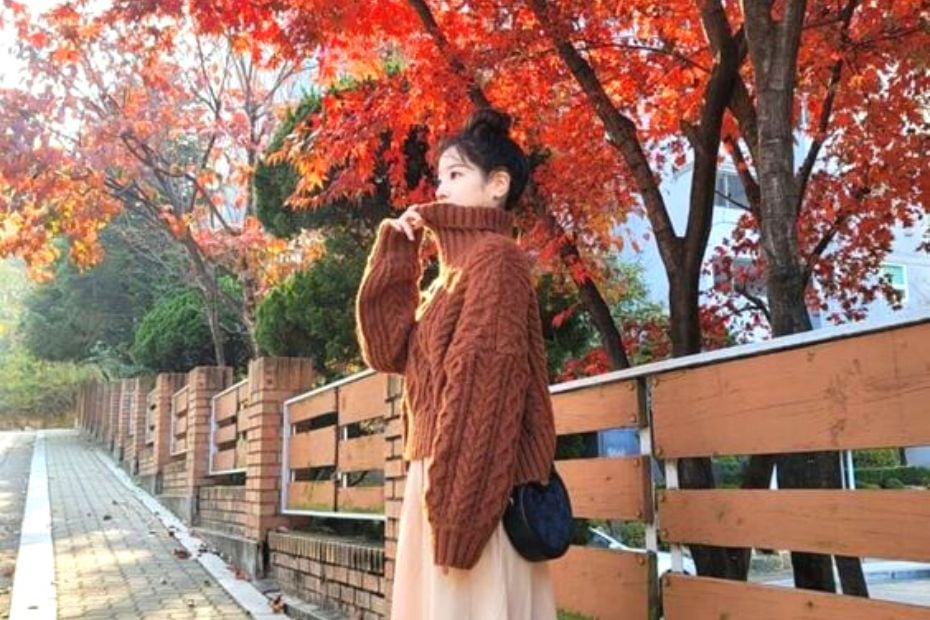
October in Korea is warm during the day, but cold at night. Temperatures typically range between 15 and 25 degrees Celsius during the day and as low as 5 to 15 degrees at night, depending on the time of month and weather conditions.
Since the weather can vary, it’s useful to pack a range of clothes for cool and warm weather. Layering will help you stay warm in the morning and evenings, but try not to wear an overly large jacket or coat as you’ll probably want to take it off and carry it during the day.
October is quite dry, so you shouldn’t need to worry too much about bringing an umbrella. You can certainly buy one easily enough in Korea. It still rains, but not as much as summer. A jacket or coat that is waterproof could be a good option to prevent coldness and to stay dry.
A t-shirt and jumper / shirt should be good for most days to keep you warm. Some people still wear shorts and a t-shirt during October, but that depends on the person. If you’re comfortable with cooler weather, then you’ll not have any problems dressing like that.
What I wear in October
This picture was taken on October 10th in Gyeongju. It was raining that day, but wasn’t that cold. I was fine in a shirt and t-shirt with jeans. I typically start wearing a woollen jumper by mid-October with jeans and walking boots. I’ll pack a light jacket if I’m planning to be out at night or hiking (it gets cold at the top). I wouldn’t recommend sandals in October, especially if you plan to do a lot of walking.

Winter usually starts around mid-November and the warm autumn weather quickly disappears before the cold winter weather arrives to freeze everything in place. Predicting the weather is very tricky, so be prepared for the worst, which would include colder weather than expected.
Packing an extra jumper or jacket is probably best. If you’re stuck with the wrong clothes in October, you can always visit the markets in Seoul and find lots of cheap clothes to keep you warm.
Tips For Visiting Korea In October
Finally, here are some of my tips to help you travel Korea in October. October is the time I’m out travelling the most in Korea and you’ll find lots of other people doing the same.
Book ahead: As I’ve mentioned, October is peak season in Korea and many things will be booked up weeks or months in advance, especially around the public holidays.
Plan your route: Be careful when travelling on trains and buses. Use Naver Maps to help you plan your route and use the official Korail website – letskorail – to book train tickets.
Expect delays: Want to visit the best autumn foliage spot when it’s just about to peak? Well, so does everyone else. Expect traffic delays, crammed buses, and long queues. That’s part of peak travel.
Pack appropriately: October is a month that swings from warm to cool and the temperatures can vary depending on where you travel. Assume the worst and bring some cold weather clothes.
Get out of the cities: The best sights in Korea during autumn are typically outside of the cities and in the national parks. There are plenty of national parks in Korea, including Bukhansan National Park which is right next to Seoul.
Join a walking tour: Walking or social tours are a great way to meet other travellers and explore more of Korea with others. You can find lots of these in the Korea Travel Advice group.
Visiting Korea In October FAQs
Finally, here are a few FAQs about visiting Korea in October, in case the above information didn’t cover enough for you. If you have any other questions you’d like to ask, feel free to leave a comment.
Is October a good time to visit Korea?
October is one of the best times to visit Korea. The weather is warm during the day, there is less rain than in summer, and the autumn foliage starts to appear across the country. There are many autumn festivals to enjoy in Korea during October, offering travellers the chance to learn about traditional Korean culture and experience unique activities.
How cold is October in Korea?
October is still warm, with average temperatures around 15 to 25 degrees Celsius during the day, even towards the end of the month. However, the temperature drops a lot at night and ranges from 5 to 15 degrees Celsius. It can drop to 0 degrees and on rare occasions can snow in October.
Can you see fall foliage in Korea in October?
October is the start of the fall foliage season in Korea, with the first foliage appearing on the northeast coast around early October, spreading down through the country over the next 4 weeks. There are many places to see autumn leaves in Korea during October.
Is it warm in Korea in October?
It’s still warm in Korea in October and winter doesn’t start until mid-November. It is warm enough to wear light clothing until mid-October. After mid-October, the weather starts to cool and warmer clothes are necessary.
How is the weather in Korea in October?
The weather in October in Korea is warm and clear, but can rain at times. October is the end of typhoon season in Korea and there may be a few days of typhoons. However, these mostly stay in the south of the country, affecting Jeju Island, Busan, and the south coast.
What should I pack for October in Korea?
Good walking boots, a light jacket, sweater, and long trousers are recommended for October in Korea. Many people visit the national parks for autumn foliage in October, so long sleeves and trousers will protect your body from scratches and walking boots will keep your feet safe.
What are the best places to visit in Korea in October?
The best places to visit in Korea during October are usually associated with autumn foliage. This includes Seoraksan, Naejangsan, and Jirisan national parks, Bulguksa Temple in Gyeongju, Asan Ginkgo Tree Road, Nami Island, and Seoul’s royal palaces. Popular activities also include visiting night markets, hiking and trekking, and bike riding.
Does it snow in Korea in October?
Snow is not common in Korea, but it can occur. In October 2021, there was snowfall on the mountaintops. However, snow in city areas is extremely rare. Normally the first snowfall of the year in Korea is in November.
Liked This? Pin It For Others
If you enjoyed reading this article, then please share this with your friends on Pinterest.
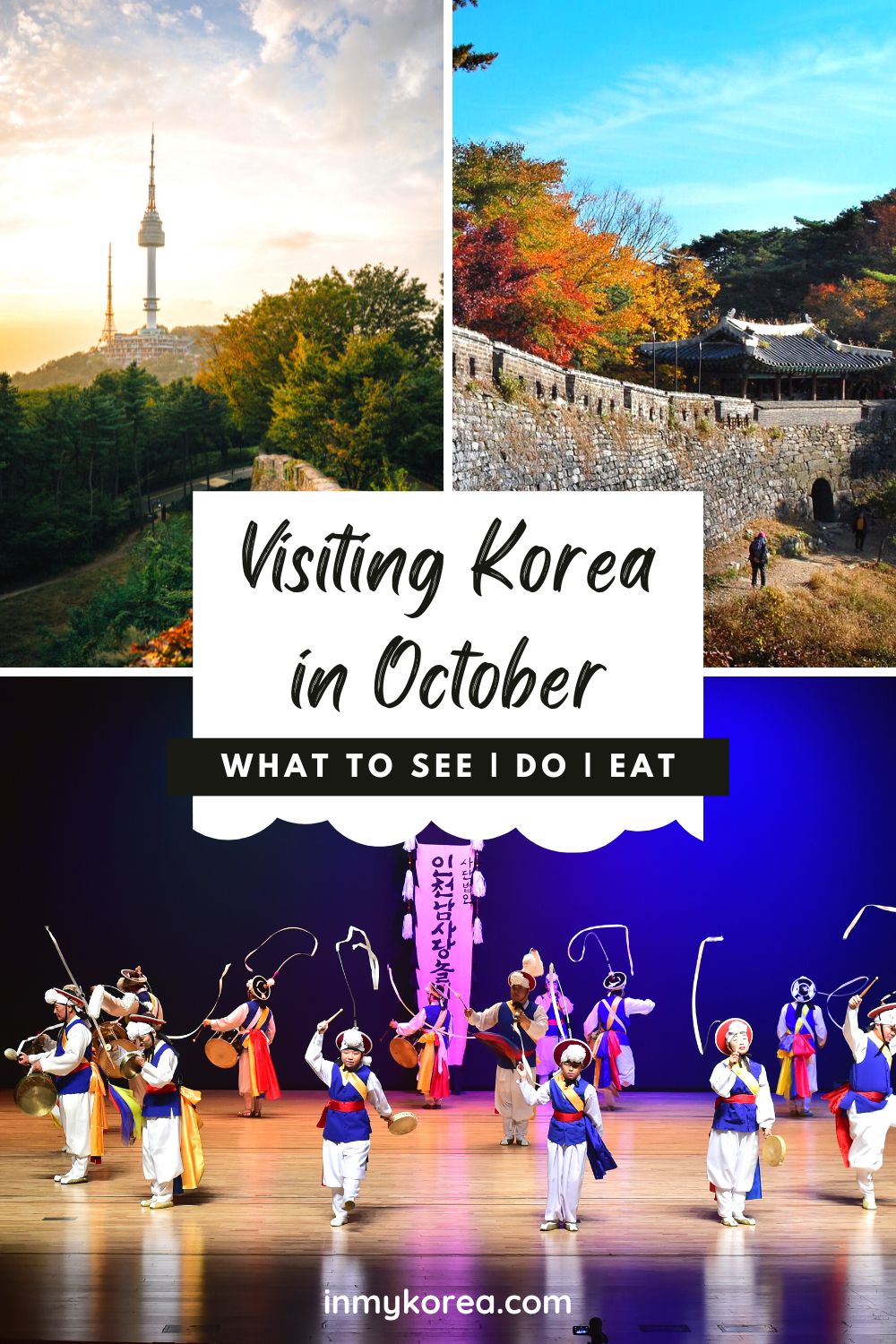

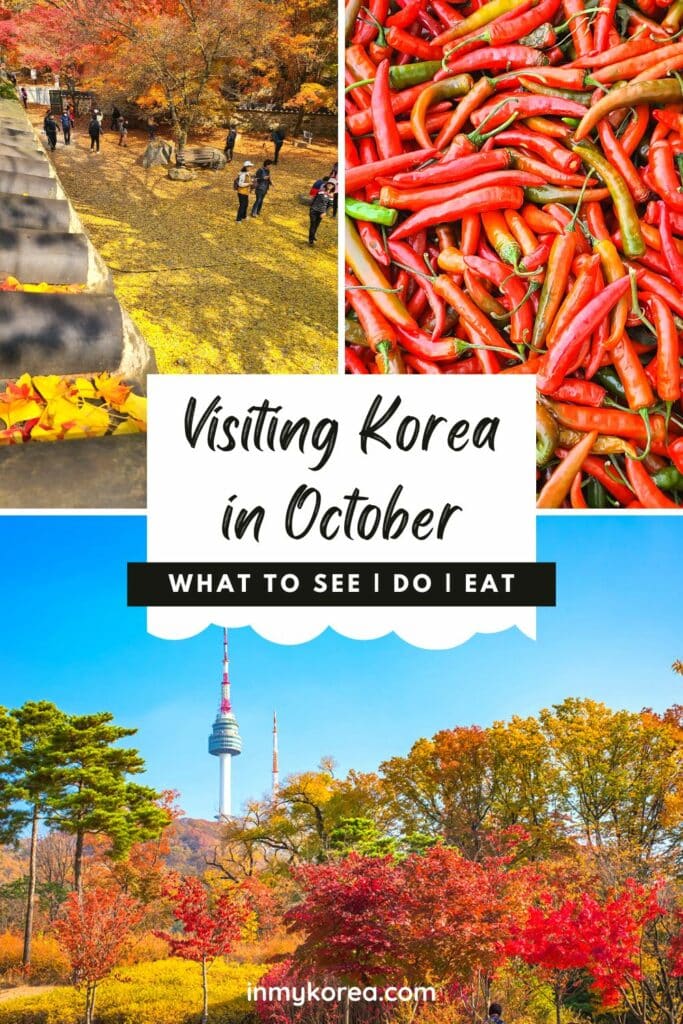


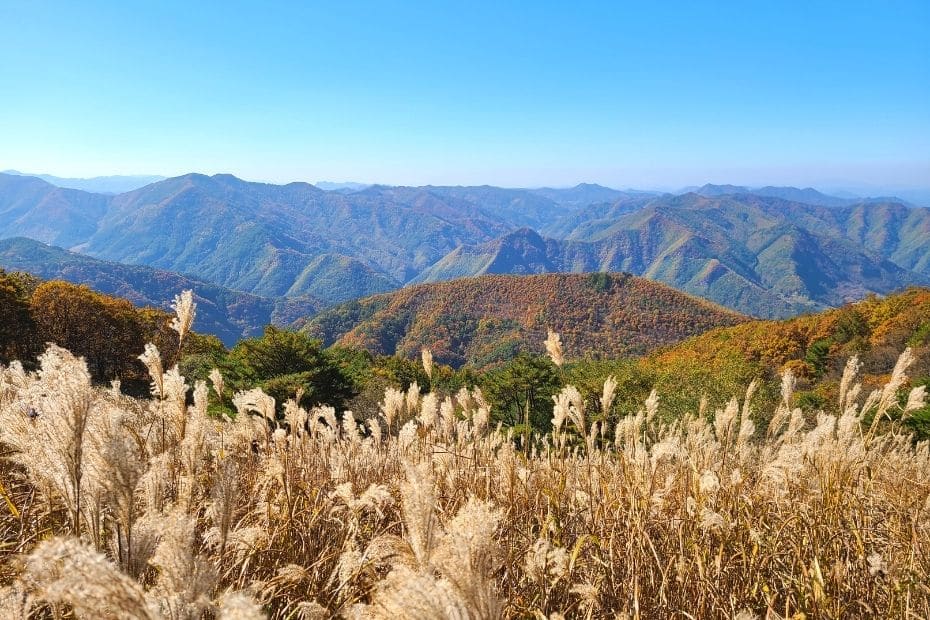
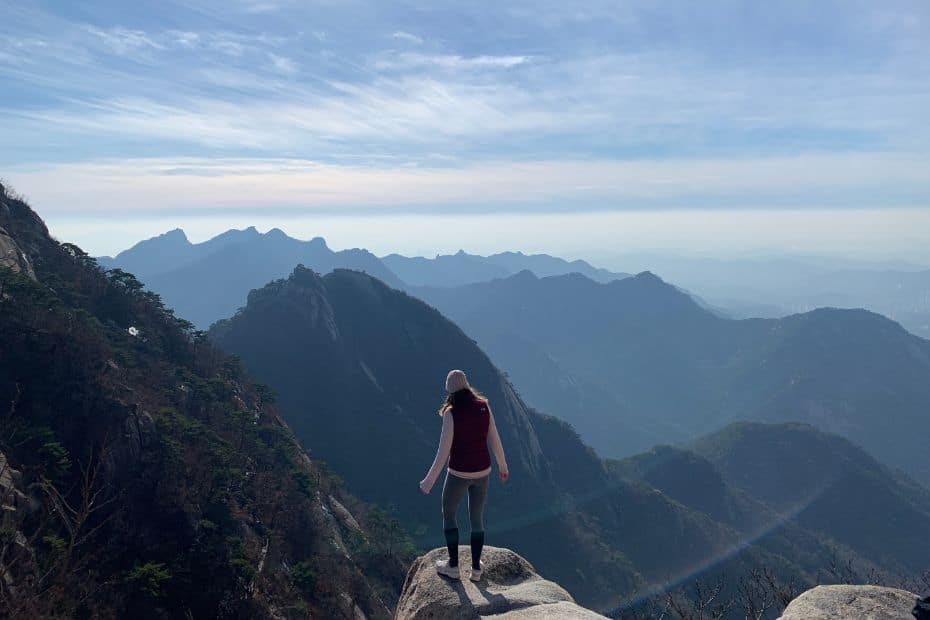
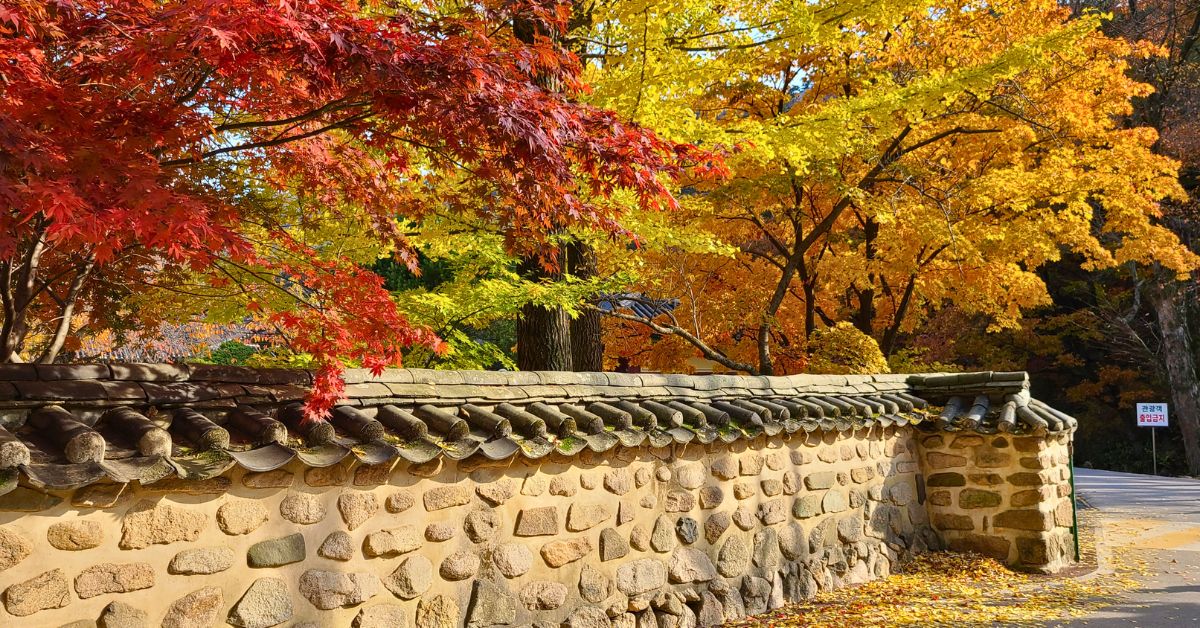

Love Korea
I want to go to Korea one time in my life
I hope you can make it soon 🙂
Joel,
Thank you for gathering all of this great information. I will be traveling to So.Korea in October 2023 with my son who is 32. I am into learning more about the Korean culture and want to take it all in. I am very excited for this trip. We are traveling from New York. We haven’t booked our flights yet, but soon!
I am going to take notes on your information and go for it!
Also, even though I am “old” I love BTS and Korean dramas!!!
Thanks again,
Carolann
Hi Carolann, thanks for the kind feedback. I hope you and your son have a great time in Korea. October is definitely one of the best times to visit and I’m sure you’ll see some incredible sights. I think the BTS Army are all ages, you’re never too old to enjoy something fun 🙂